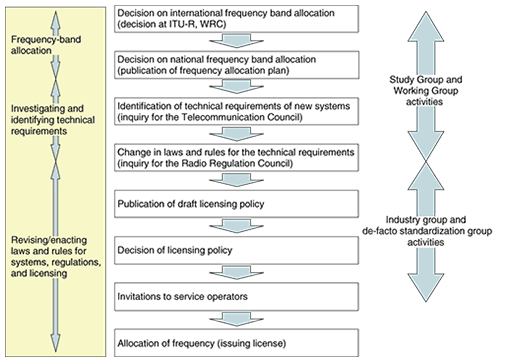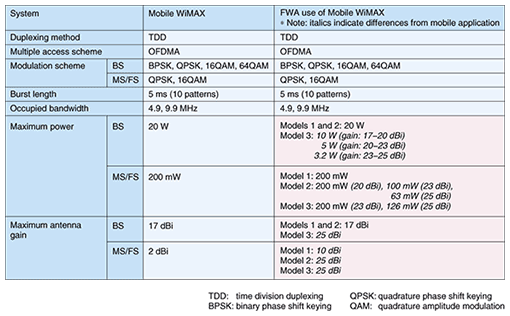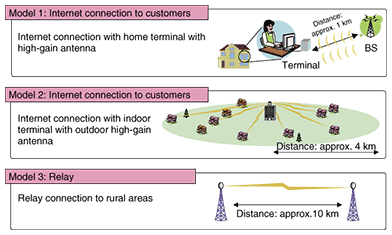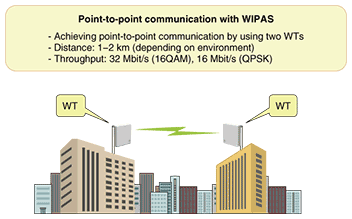 |
|||
|
|
|||
|
Global Standardization Activities Vol. 6, No. 10, pp. 31–36, Oct. 2008. https://doi.org/10.53829/ntr200810gls Standardization Activities and Advances in Broadband Wireless AccessAbstractThis article describes how broadband mobile wireless access (BWA) systems have been made ready for service and mentions the advances that are underway. It also covers topics associated with fixed wireless access systems that use the quasi-millimeter wave band. Technical requirements for BWA systems like WiMAX have been clarified in reports as responses to the Inquiry by the Ministry of Internal Affairs and Communications (MIC) for the Telecommunication Council. Frequency bands for national-band and regional-band BWA services have been allocated, and the services will start soon.
1. Importance of frequency allocationStandardization activities are crucial if telecommunication services are to provide lower costs, utilize common commercial parts, and share the same worldwide specifications. A key difference that differentiates wireless communication systems from other systems is the need to standardize the spectrum utilized, in addition to system specifications, to establish communications between base stations (BSs) and mobile stations (MSs) or fixed stations (FSs) and between access points (APs) and wireless terminals (WTs). The process from worldwide spectrum allocation to the introduction of a new wireless service is shown in Fig. 1. Spectrum is first allocated by an international organization such as ITU-R (International Telecommunication Union Radiocommunication Sector) and WRC (World Radiocommunication Conference). Then, each country decides which system/service should use the spectrum depending on the country's demands and/or environments.
2. Proposal of new systems and clarification of their technical requirementsNew systems are generally proposed by study groups or industry organizations, and their technical requirements are investigated in Japan at the Technical Council in response to one or more Inquiries issued by the Ministry of Internal Affairs and Communications (MIC). This article looks at an example taken from the case of broadband mobile wireless access (BWA) systems. Discussions on the new wireless service and its spectrum usage can be traced back to the Study Group for Wireless Broadband Promotion in 2004, which was formed under MIC. This Study Group focused on developing the world's most advanced wireless broadband service environment and providing concrete measures for frequency reallocation. Topics discussed were: i) study of developments made in domestic and international wireless services, ii) identification of future wireless broadband usage and markets, and iii) identification of challenges in wireless broadband promotion, examination of measures to encourage promotion, etc. Taking into account users' viewpoints, wireless services were reviewed and categorized into four major applications: i) next-generation mobile radio communication systems and mobile offices/homes, ii) alternatives to wired broadband, iii) ITS (intelligent transport systems), and iv) next-generation intelligent home applications. For each of these applications, example systems and frequency bands suitable for service provisioning were further investigated. Specifically, the first and second applications are systems for wireless communication services. The final report of the Study Group was published in December 2005 [1]. Based on this report, MIC decided to open the 2.5-GHz band, which was originally reserved for IMT-2000 (International Mobile Telecommunications-2000), to the BWA systems. 3. Investigations of the Telecommunications CouncilTo determine the spectrum usage and guidelines for possible systems, MIC issued Inquiry No. 2021 on February 27, 2006 to the Telecommunications Council for “Technical Requirements for Broadband Mobile Wireless Access Systems Using the 2.5 GHz Band”. The Council submitted two partial reports as partial responses to the Inquiry on December 21, 2006 and April 26, 2007. The first one, for mobile service, identified systems suitable for 2.5 GHz and clarified their technical requirements [2]. The second one, for fixed wireless access (FWA) service, was produced in response to demands for such a service submitted to MIC at a public hearing. Technical requirements for the stationary use of mobile systems and regional sharing measures for BWA were investigated and reported [3]. 4. Technical requirements for BWAThe investigation of BWA systems started with an invitation for the submission of potential systems. Because the frequency band reserved for IMT-2000 was released to the new systems, such systems were expected to have performance at least equivalent to IMT-2000. The criteria were as follows: i) High-speed downlink transmission: 20–30 Mbit/s, ii) Appropriate uplink transmission: 10 Mbit/s or higher, and iii) Frequency efficiency higher than 3 G/3.5 G systems (G: generation). Four systems (Mobile WiMAX, next-generation PHS (personal handy-phone system), MBTDD Wideband, and MBTDD 625k-MC (MBTDD: mobile broadband time division duplexing)) were scrutinized by the Telecommunication Council, which finally concluded that all of them met the performance requirements. It is important to consider existing services when deciding frequency allocation. The 2.5-GHz-band considered at this time actually runs from 2535 to 2630 MHz. Two existing services use adjacent ranges: a satellite mobile communication service at 2505–2535 MHz and a mobile broadcasting service at 2630–2655 MHz. As any new service should attempt to minimize interference with existing services, guard bands not used by any system were set at 2535–2545 MHz and 2625–2630 MHz. Moreover, the guard bands for two adjacent newly introduced systems were determined as 1 MHz with synchronization and 5 MHz without synchronization. In addition, system specifications were also determined. The case for Mobile WiMAX is listed in Table 1.
5. BWA systems for FWA serviceStrong demands for BWA systems in rural areas to provide FWA service were received in both the public comments and the presentations made to MIC. Hence, the Telecommunication Council discussed and submitted the second partial report entitled “Technical Requirements for High-gain FWA Systems” on April 26, 2007. Service models for the investigations were first identified, and interference between them was then evaluated. Mobile WiMAX and next-generation PHS were chosen to be reviewed. Three models to cover different usage scenarios were proposed: Model 1: Internet connection with a home terminal with a high-gain antenna, Model 2: Internet connection with an indoor terminal with an outdoor high-gain antenna, and Model 3: relay connection to rural areas (see Fig. 2).
The results for interference between services suggested that the BS and MS should be separated by some distance and site engineering used to reduce the impact of interference. The reductions in interference were determined as follows. 1. Mobile to mobile Distance between BS and MS is several kilometers (assuming non-line-of-sight communication) 2. Mobile to FWA (1) Mobile BS to FWA station: 60–80 dB (2) Mobile station to FWA BS: 35–60 dB 3. FWA to FWA FWA BS to FWA station: 50–72 dB 6. Licensing policy and operators to whom licenses were grantedThanks to these reports from the Telecommunication Council, the licensing policy was finalized [4], [5]. The 2.5-GHz band includes two 30-MHz bands to be used for nationwide mobile services and a 10-MHz band in between them for regional services to address digital divide issues and provide better regional public welfare. For the mobile services, UQ Communication (using WiMAX) and Willcom (using next-generation PHS) were granted licenses on December 21, 2007 [6]. Applications for the regional service were accepted starting on March 3, 2008, and licenses were granted to 42 organizations on June 16, 2008 [7]. 41 of them are cable television (CATV) companies, while one is a telecommunication operator. Most will start their business in 2009. 7. Progress in WiMAXWiMAX (worldwide interoperability for microwave access) is a nickname covering systems that are compliant with IEEE802.16 and certified by the WiMAX Forum [8]. The number of WiMAX Forum member continues to increase steadily, and total membership now exceeds 500. The forum is composed of nine working groups, which investigate technical issues, network specifications, strategic frequency allocation, marketing, worldwide roaming, and so on. The IEEE802.16 standard was the basis for FWA services when the committee was established. The standard was expanded and amended as work progressed, and it was eventually extended to support mobile services. Hence, the first WiMAX is actually a fixed WiMAX based on IEEE802.16-2004 WirelessMAN OFDM (MAN: metropolitan area network, OFDM: orthogonal frequency division multiplexing). The system attracting the most attention now is mobile WiMAX based on IEEE802.16e-2005 WirelessMAN OFDMA. IEEE802.16 activities include approval of IEEE802.16g, and TGm (Technical Group m) is expected to make progress in evolving WiMAX to IMT-Advanced with the liaison of the WiMAX Forum. WiMAX certification has already been granted to 3.5-GHz fixed WiMAX. The first mobile WiMAX was certified in April 2008. The only WFDCL (WiMAX Forum Designated Certification Laboratory) able to test systems for certification was AT4Wireless in Spain when the certification process started. Now there are six organizations: AT4Wireless (Spain), AT4Wireless (USA), TA (Korea), CATR (China), ADT (Taiwan), and TTC-CCS (Taiwan). As described so far, the regulations, specifications, manufacturing, and certification for mobile WiMAX are making steady progress towards the provision of a complete service. 8. FWA systems in quasi-millimeter wave bandFWA systems in the quasi-millimeter wave band have advantages in terms of utilizing spectral resources over ones in the microwave band. This means that the number of channels available for communications can be increased, which makes it possible to more easily provision all necessary areas with broadband services. One example of such systems is the WIPAS (Wireless IP Access System) developed by NTT. Although its AP and WT need to be placed in line of sight, its throughput is up to 46 Mbit/s. When used in combination with optical communication, it can provide broadband B FLET'S service through the concept of “Fiber + Radio”, shown in Fig. 3. It can also provide point-to-point communication service, as shown in Fig. 4.
WIPAS complies with the ARIB (Association of Radio Industries and Businesses) standard as subscriber wireless systems for quasi-millimeter and millimeter bands: the standard names are ARIB-STD T-58 and T-59, respectively. In addition to domestic deployment in Japan, WIPAS has been deployed in other countries. In Chile, it has been used to form communication systems for observation networks in mining areas. In south Asian countries, it is used to build up regional infrastructures as part of the APT (Asia-Pacific Telecommunity) project [9]. While WIPAS has been developed to provide Internet service, the next WIPAS version is being developed to provide triple play (Internet access, television, and telephone) services to complement fiber to the home (FTTH), following the concept of “Fiber + Radio”. The new system will use three-dimensional monolithic microwave integrated circuits (3D-MMICs) as the radio frequency (RF) circuits, which increases the chance of deployment because they broaden the operational frequency range. Furthermore, WIPAS will be able to provide triple play services while maintaining compatibility with GE-PON (Gigabit Ethernet passive optical network). As described above, the FWA systems are continuing to be developed to provide attractive services. References |
|||













